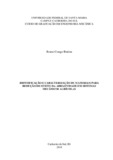| dc.contributor.advisor | Santos, César Gabriel dos | |
| dc.creator | Batista, Bruno Cougo | |
| dc.date.accessioned | 2019-11-25T20:09:51Z | |
| dc.date.available | 2019-11-25T20:09:51Z | |
| dc.date.issued | 2018 | |
| dc.date.submitted | 2018 | |
| dc.identifier.uri | http://repositorio.ufsm.br/handle/1/19053 | |
| dc.description.abstract | Agricultural activity in Brazil is responsible for 23% of the Gross Domestic Product,
and is inserted in the primary sector of the economy, which is characterized by the
exploitation of natural resources, and the sector is responsible for supplying the raw material
for the various branches of industry . In this context, the Agricultural Machines responsible
for harvesting most of the grain production (soybean, corn, beans, wheat and rice) are called
harvesters who in 2017 reached the mark of 4537 units sold in the national market. Harvesters
have high added value, use the most advanced materials and production technologies
available to the industry. Rio Grande do Sul is the largest rice producing state, with 67% of
national production, most of which is harvested by the harvesters. Rice is characterized by
being a material with a high level of abrasiveness when compared to other crops, such as soy
and corn. In this context, the identified engineering problem consists of the accelerated wear
of the components of the harvester which are in contact with the grain of the rice crop, more
specifically in the grain transport components. The main objective of this work was to
identify and characterize materials used as an alternative to reduce abrasive wear present in
agricultural machines. Through data obtained by quality certificates and researches with
suppliers, the materials currently used (SAE 1010) as well as the materials used as solution
alternatives for abrasive wear were identified (Inox 304, Hardox 400 and Steel bound to Boro
27MnCrB5) . The results were presented in the form of objective comparison through tables
and brief discussions. Comparing costs, processes and the index of resistance to abrasive
wear, it was concluded that the most suitable material, among those selected for the described
problem, is the 27MnCrB5 boron-bound steel. | eng |
| dc.language | por | por |
| dc.publisher | Universidade Federal de Santa Maria | por |
| dc.rights | Acesso Aberto | por |
| dc.subject | Colhedoras | por |
| dc.subject | Desgaste | por |
| dc.subject | Arroz | por |
| dc.subject | Alternativas | por |
| dc.subject | Abrasão | por |
| dc.subject | Materiais | por |
| dc.subject | Harvesters | eng |
| dc.subject | Wear | por |
| dc.subject | Rice | eng |
| dc.subject | Alternatives | por |
| dc.title | Identificação e caracterização de materiais para redução do efeito da abrasividade em sistemas mecânicos agrícolas | por |
| dc.title.alternative | Identification and characterization of materials to reduce the effect of abrasivity in agricultural mechanical systems | eng |
| dc.type | Trabalho de Conclusão de Curso de Graduação | por |
| dc.degree.local | Cachoeira do Sul | por |
| dc.degree.graduation | Curso de Engenharia Mecânica | por |
| dc.description.resumo | A atividade agrícola no Brasil é responsável por 23% do Produto Interno Bruto, e está
inserida no setor primário da economia, o qual se caracteriza pela exploração de recursos
naturais, sendo o setor responsável por fornecer a matéria-prima para os diversos ramos da
indústria. Neste contexto, as Máquinas Agrícolas responsáveis por colher a maior parte da
produção de cereais (soja, milho, feijão, trigo e arroz) são denominadas de colhedoras que no
ano de 2017 alcançaram a marca de 4537 unidades comercializadas no mercado nacional. As
colhedoras possuem um alto valor agregado, utilizam os mais avançados materiais e
tecnologias de produção disponíveis para o setor. O Rio Grande do Sul é o maior estado
produtor de arroz, com 67% de produção nacional, sendo que sua colheita é realizada na
maior parte pelas colhedoras. O arroz tem por característica ser um material com elevado
nível de abrasividade quando comparada com outras culturas, como soja e milho. Neste
contexto, o problema de engenharia identificado consiste no desgaste acelerado dos
componentes da colhedora que estão em contato com o grão da cultura do arroz, mais
especificamente nos componentes de transporte do grão. O presente trabalho teve como
objetivo principal, identificar e caracterizar materiais utilizados como alternativa para redução
do desgaste abrasivo presente em máquinas agrícolas. Através de dados obtidos por
certificados de qualidade e pesquisas junto a fornecedores, foram identificados os materiais
utilizados atualmente (SAE 1010) bem como os materiais usados como alternativas de
solução para o desgaste abrasivo (Inox 304, Hardox 400 e Aço ligado ao Boro 27MnCrB5).
Os resultados obtidos foram apresentados em forma de comparação objetiva através de
tabelas e breves discussões. Comparando custos, processos e o índice de resistência ao
desgaste abrasivo, concluiu-se que o material mais adequado, dentre os selecionados para o
problema descrito, é o Aço ligado ao Boro 27MnCrB5. | por |
| dc.publisher.country | Brasil | por |
| dc.publisher.initials | UFSM | por |
| dc.subject.cnpq | CNPQ::ENGENHARIAS::ENGENHARIA MECANICA | por |
| dc.publisher.unidade | UFSM Cachoeira do Sul | por |


